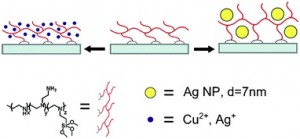 To catch a bacterial infection after a visit to a hospital for a health checkup is not a funny way to become sick. Even worse is when the infection came from a device which was supposed to help you to get better, not sicker, such as a medical device. Intra-hospital infections are difficult to avoid as some viruses or bacterias deposit on any surface available, which may become in contact with a healthy person, with potential health consequences. Numerous approaches have been looked at in order to create materials with anti-bacterial capabilities. In this direction, silver and copper nanoparticles (AgNP and CuNP) are attractive as they may be able to avoid propagation of several microorganisms, including E. coli and S. aureus. Several methods have been tried to successfully immobilize the nanoparticles to a surface.
To catch a bacterial infection after a visit to a hospital for a health checkup is not a funny way to become sick. Even worse is when the infection came from a device which was supposed to help you to get better, not sicker, such as a medical device. Intra-hospital infections are difficult to avoid as some viruses or bacterias deposit on any surface available, which may become in contact with a healthy person, with potential health consequences. Numerous approaches have been looked at in order to create materials with anti-bacterial capabilities. In this direction, silver and copper nanoparticles (AgNP and CuNP) are attractive as they may be able to avoid propagation of several microorganisms, including E. coli and S. aureus. Several methods have been tried to successfully immobilize the nanoparticles to a surface.
Giacomo Dacarro and coworkers at the Università degli Studi di Pavia at Italy, have devised a new way to chemically modify Si-OH terminated surfaces (glass, quartz, SiO2) by using a novel silane-derivatized polyethylenimine (PEI) and testing its ability to coordinate Ag+ and Cu2+ ions, and silver nanoparticles. The functionalized glasses are very effective in fighting against E. coli and S. aureus propagation, and may be an novel platform for use in designing smart, hybrid multifunctional materials.
Read more about his paper published in Dalton Transactions.
Monolayers of polyethilenimine on flat glass: a versatile platform for cations coordination and nanoparticles grafting in the preparation of antibacterial surfaces
Giacomo Dacarro, Lucia Cucca, Pietro Grisoli, Piersandro Pallavicini, Maddalena Patrini and Angelo Taglietti
Dalton Trans., Advance Article, 2012.
DOI: 10.1039/c1dt11373a










